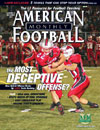AMERICAN FOOTBALL MONTHLY THE #1 RESOURCE FOR FOOTBALL COACHES
Article CategoriesAFM Magazine
|
The Drills Report - Zone Blocking: Run Game Drillsby: Ken WilmesherrOffensive Line Coach, Grossmont College © More from this issue In this article we will cover some of the drills we use to develop our offensive linemen for the run game. Drills are where you develop your offensive linemen into playmakers. It’s difficult to teach technique and fundamentals during team practice. Instead, in team you should see your drills being put into use. Here are seven important points when teaching drills: 1. Teach a handful of drills. 2. Teach the fundamentals (‘Fundamentals Wins Games’). 3. Rep everything and get as many reps as possible but remember attention to detail. Repetition must be accepted as a way of life for an offensive lineman. 4. The drills you teach must transfer to the game. 5. It is important you coach the defenders in your drills. 6. Demand great effort from your players. 7. Your players must fi....The full article can only be seen by subscribers. Subscribe today!
|
|
|||||||
| HOME |
MAGAZINE |
SUBSCRIBE | ONLINE COLUMNISTS | COACHING VIDEOS |
Copyright 2025, AmericanFootballMonthly.com
All Rights Reserved





